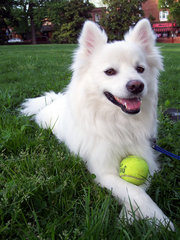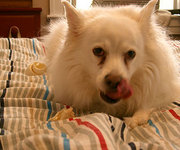German Spitz
American Eskimo Spitz
|
Dog breeds of the world, American Eskimo Dog |
| American Eskimo Dog | ||
|---|---|---|
| Alternative names | ||
| American Eskimo German Spitz American Eskimo Spitz |
||
| Country of origin | ||
| United States | ||
| Common nicknames | ||
| Eskie, Eskimo, Spitz | ||
| Classification and breed standards | ||
| AKC: | Non-sporting | |
| CKC: | Miscellaneous Class | |
| UKC: | Northern Breeds | |
| Not recognized by any major kennel club | ||
| This breed of Dog is extinct | ||
| Notes | ||
| This breed achieved recognition by the CKC in 2006 [3] | ||
The American Eskimo Dog is a breed of companion Dog originating in the United States of America (probably in New York City) in the twentieth century. The breed was formerly called a German Spitz or an "American Eskimo Spitz". It is a member of the Spitz family of Dogs. It achieved a high degree of popularity in the 1930s and 1940s in the U.S. as a circus performer. The American Kennel Club recognized the breed in 1994 and set the current standard for the breed. The United Kennel Club had recognized the breed long before 1994, and there is no difference between the two breed standards.
 American Eskimo Dogs are always ready to play.
American Eskimo Dogs are always ready to play.
The standard for the American Eskimo Dog calls for them to be white or white & cream, with brown eyes (blue eyes, such as those found on the Siberian Husky, are a disqualification and a sign of poor health or breeding), and a compact body. The Dog's length should be only slightly greater than its height at the shoulder. The muzzle is long and lupine (in contrast to the muzzles of Pomeranians). The ears are held erect and alert, and the tail should be feathered and curled on the Dog's back. These Dogs look very much like smaller versions of the Samoyed, to which they are related, and come in three standard sizes. The toy is from 9 to 12 inches (23 to 30 cm) at the withers; the miniature is from 12 to 15 inches (33 to 38 cm); the standard is from fifteen inches up to and including nineteen inches (39 to 48 cm).
The Eskie, as with all Nordic breeds, has erect, triangular ears ("prick ears"), a tail that flips onto the Dog's back in a spiral, and two coats of fur: an inner, downy coat, and an outer coat of guard hairs that act as weather protection.
American Eskimos were bred to be companion Dogs, not just the family Dog to put outside when they bother their owners. They thrive on being a part of their human family. Eskies love their families, and a well-socialized Dog is more of a pleasure to own. Eskies are easily trained and very intelligent, as well as being strong-willed and independent. At home, Eskies make excellent watchDogs, barking to announce the presence of strangers. The Eskie can be protective of its home and family, but it shouldn't threaten to attack or bite a person.
Many people find the puppies of American Eskimo Dogs to be very cute and purchase this breed as a puppy without doing sufficient research, such as discovering the longevity and needs of this breed. This breed can take longer to mature than other breeds, and Eskies can behave more like puppies than like adults for up to two years, when they finally start to mature and grow their adult coats. They are also an extremely intelligent Dog and need to be stimulated. When their intelligence is not stimulated or they are ignored, they can develop behavior issues. Owners can avoid this problem by socializing their Eskie through obedience training or participating in Dog sports, such as Dog agility, flyball, or dancing.
The breed lives on average between 12 and 13 years, although some individuals might as long as 20 years or longer.
The American Eskimo Dog, or "Eskie" as it is often called, is most likely derived from the German Spitz, the Finnish Spitz, the Pomeranian, the Keeshond, and possibly the Samoyed, although the latter is not universally accepted. The Spitz family of Nordic Dogs is one of the least altered by human husbandry and reflects most nearly the prototypical Dog, from which stock all others have been derived. Archeology suggests that Neolithic Dogs living with humans would today pass for spitzes.
 Like many light-colored Dogs, the fur beneath the eyes can become stained if not
regularly cleaned.
Like many light-colored Dogs, the fur beneath the eyes can become stained if not
regularly cleaned.
Eskies have a long, dense coat and need regular grooming. This means brushing them once a week, or more often if necessary. They shed, but it can be maintained with regular brushing. They "blow" their coats twice a year, once in May or June to shed their winter undercoat and once in November or December to shed their summer coat. Many Eskie owners use an undercoat rake, a tool available at most pet stores, for grooming.
Eskies have drier skin than most other Dogs and do not usually smell Doggy. Because of their dry skin, they need to be bathed only every two or three months, unless they soil their coat with large amounts of dirt or substances with strong odors. Regular brushing maintains a clean coat in most cases. Eskies are very clean about themselves and constantly groom themselves.
All Dogs' teeth should be brushed once a week. Pet stores carry a variety of Dog toothbrushes, from fingertop to electric.
Because so many people purchase "cute" puppies and then discover that they do not want an active, intelligent Dog with a heavily shedding coat, many of this breed end up at the animal shelter or otherwise up for adoption. There are many breed-specific rescue groups that are more than willing to give advice on training or curbing behavioral issues.